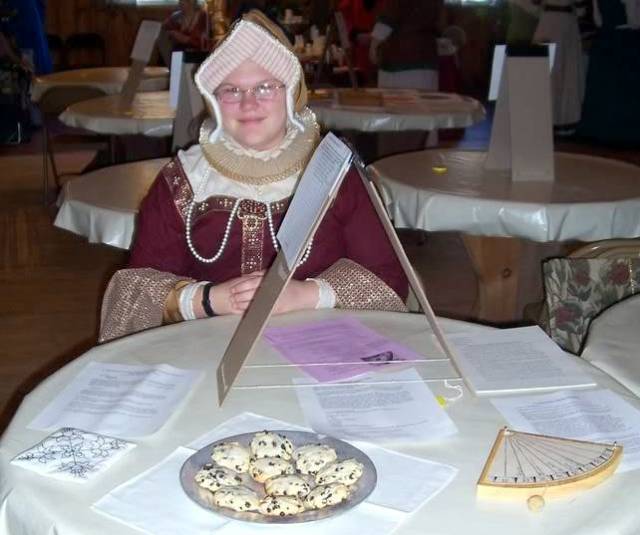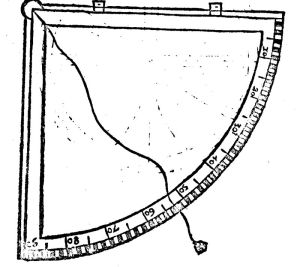 Originally entered at Northern Lights 14(?) around 2005. This was my very first A&S project. I don’t have any close-up pictures of my finished project, unfortunately.
Originally entered at Northern Lights 14(?) around 2005. This was my very first A&S project. I don’t have any close-up pictures of my finished project, unfortunately.

Northern Lights, 2005, with my embarrassing early garb. I entered an herbal sleep pillow, excellent small cakes, and a quadrant.
Entered in: Miscellaneous. Didn’t win anything.
Materials: Wood, paper, brass eyes, woollen yarn, beeswax, lead musket ball
What: A navigational instrument used for calculating latitude using the height of the North Star.
When: Quadrants were used from the 14th century on; the use of New World ports on this one dates it to later in the period.
Where: These were commonly used by Portuguese navigators; however, their ease of use and relative accuracy made them popular on many European vessels. This one is English (as seen by the English place names).
I was inspired to make a quadrant after spending a month and a half serving as crew aboard a modern-day tall ship, where we sailed solely by celestial navigation. The quadrant is the precursor of the modern sextant (so named as it is the sixth part of a circle, rather than the quadrant’s fourth). To use, the North Star is sighted in both brass eyes and the string’s position on the arc is noted. Many quadrants show ports put on the lines where they are found, so that a navigator would simply have to ensure they stayed at the same latitude and then sailed east or west until making landfall, hopefully near the desired city. As with all navigational instruments, there is a margin of error in the instrument’s accuracy. Inaccuracies in measurements, the placing of the sighting eyes, and the basic difficulty of ascertaining a fixed position from a moving vessel all can affect the precision of any course set. This particular quadrant hasn’t been tested yet, although I hope to try it soon. And of course, determining longitude at sea was impossible until the invention of the marine chronometer by John Harrison in the 1760s1.
Procedure:
Body: My lord’s father had this scrap of pine pre-cut in his basement, probably with a power saw. He had sanded the edges (I am aware that sandpaper was not invented until out of period, though dried sharks’ skin or horsetail/scouring rush was available and used in period) to a slight round.
Face: The face is heavy card stock, cut to match the curve of the wood. I looked up important trading ports (or ports of other importance; Veracruz, for example, is the location of San Juan de Ulua, site of a famous raid by Sir Francis Drake) to put at strategic points on the face. The ink is a generic black ink I found in an unmarked bottle in my desk drawer; but I wrote using a seagull pinion (geese being scarce) sharpened with my jackknife.
Weight: The weight is a cast lead musket ball, fished out of a woodpile following an early 19th century reenacted militia drill. Consequently, the ball is for an out of period weapon, but a similar sized lead ball would have been easily available. The line is woollen, tied around the ball in a monkey’s fist. Although I looked, I was unable to find any date of origin for that knot.
Finishing: Most wooden materials in period were finished with paint, if they were finished at all. Varnishes could be turpentine, beeswax and/or linseed oil.2 With the quadrant, I faced several problems: I needed to affix my paper face to the wood in such a manner as to protect it and ensure it would stay, protect the wood and string, and make sure the monkey’s fist could not work itself loose. Glues in period were made of hide and usually not waterproof, though some varnishes could be used for the purpose and would stand up well to water.3 Beeswax could be used as a finish, but usually was not, as wax was more valuable and not feasible for larger projects. However, as the quadrant is relatively small, it would not be a problem. Using a tea-candle-powered hot-wax scent diffuser, I kept the wax hot while applying with a brush. I coated the entire board and paper face separately, then positioned the face in the right place. To even out the coat and solidly affix the face, I put the quadrant in the oven, set at 150 degrees, for a few minutes until the wax was liquid, then pulled it out to cool. The first time, there were still air bubbles under the face, so I repeated the heating process. The second time worked. I scraped off the excess wax with a metal flat-edge and burnished the entire thing with a cloth. The eyes were positioned and screwed into place, with the weighted string then tied to the corner one.
Sources:
- Fisher, Dennis. Latitude Hooks and Azimuth Rings. International Marine: Camden, ME. 1995.
- Halstead, Gary. “Interior Wood Finishing in Medieval and Renaissance Europe.” http://www.medievalwoodworking.com/articles/finishing2.htm
- National Maritime Museum, England. “John Harrison and the Longitude Problem.” http://www.nmm.ac.uk/server/show/conWebDoc.355/viewPage/1
- Various Authors. “Glue,” Stefan’s Florilegium. http://www.florilegium.org/files/CRAFTS/glues-msg.html
1 John Harrison and the Longitude Problem: http://www.nmm.ac.uk/server/show/conWebDoc.355/viewPage/2
2 Halstead, Gary. “Interior Wood Finishing in Medieval and Renaissance Europe.” http://www.medievalwoodworking.com/articles/finishing2.htm
3 Various Authors. “Glue,” Stefan’s Florilegium. http://www.florilegium.org/files/CRAFTS/glues-msg.html

